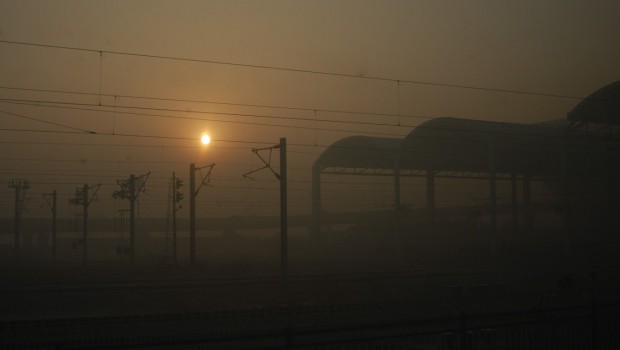Beyond Beijing: Interactive map of China’s cities affected by emergency levels of air pollution

Residents in twenty-nine Chinese cities experienced more than a month of “emergency” air pollution levels last year, according to an analysis of newly published data by Unearthed and Greenpeace China.
The collated real-time government data suggests nine large cities in China actually experienced more days of emergency smog levels than the capital – Beijing.
This analysis came after a winter of soaring air pollution levels in China’s cities and as the country’s leaders “declared war on air pollution”, comparing the issue to poverty and capping or cutting coal use in many regions.
China’s capital declares an air pollution emergency when levels of fine particulates (PM2.5) breach the emergency level of 150 migrograms per cubic metre or more in a day. The emergency threshold of PM2.5 correlates closely to the ‘very unhealthy’ band of the US Environmental Protection Agency’s Air Quality Index (AQI).
Other stories in our China series:
- China air pollution Q&A
- Interactive Map: Health impact of China’s coal plants mapped
- In pictures: How China’s air pollution spread
When Beijing’s emergency threshold has been passed, alerts are issued on the radio and TV. Then action is taken depending on the severity of the air pollution, including measures such as reducing numbers of cars on the road, ‘vulnerable’ groups such as the elderly and children staying indoors, and power plants being instructed to cut emissions – measures that were taken this winter during bad episodes.
PM 2.5 is small enough to penetrate the lungs, which is why long-term exposure can lead to heart disease, strokes, and lung disease, including cancer, according to the World Health Organisation. It can also trigger asthma attacks in the short-term.
See our league table of the ten cities in China that were exposed to bad air pollution for the most number of days last year, below.
| City | Days of ‘very unhealthy’ or above |
| Xingtai | 129 |
| Shijiazhuang | 119 |
| Baoding | 99 |
| Handan | 95 |
| Hengshui | 94 |
| Langfang | 87 |
| Jinan | 76 |
| Tangshan | 75 |
| Zhengzhou | 66 |
| Beijing | 60 |
Heading up the league table of most emergency smog days last year is the city of Xingtai, a city in the heavily-industrial Hebei province to the southwest of Beijing, which suffered more than double the amount of days over the emergency level than Beijing.
Xingtai’s 7.1m citizens experienced 129 days of emergency level air pollution – more than a third of a year blanketed in the stuff – whereas Beijing’s 11m residents experienced 60 days. Shijiazhuang, at number two, is the capital of Hebei (pictured at the top). In fact, seven of the top ten cities are in Hebei province.
You might have heard of Harbin, a city to the northeast of Beijing that was covered in the media for some off-the charts daily highs of PM2.5 at 756 micrograms per cubic metre at its peak (Fewer than Langfang in Heibei province, which spiked at 772 micrograms per cubic metre). But Harbin had exposure to less emergency level days than Beijing, at 50, and made number 16 in the league table.
In the map, the size of the bubbles represent the number of days at emergency levels of air pollution in China’s cities. It shows there are concentrations of exposure to dangerous levels of air pollution in two main areas: south of Beijing in the industrialised provinces of Hebei, Shandong and Henan; and to the west and northwest of Shanghai, another industrial heartland.
These are densely populated cities that are highly affected by air pollution – in the top ten alone, more than 30 million people live with these episodes of very unhealthy (or worse) air pollution, and in the 29 cities that have suffered a month or more of emergency level air pollution there are around 90 million people.
* Access the underlying data behind this article. Let us know if you create your own infographics from our data.
**Additional reporting by Lauri Myllyvirta

